

'Time Crystals' Could Upend Physicists' Theory of Time. Physicists plan to create a “time crystal” — a theoretical object that moves in a repeating pattern without using energy — inside a device called an ion trap.

Image: Hartmut Häffner In February 2012, the Nobel Prize-winning physicist Frank Wilczek decided to go public with a strange and, he worried, somewhat embarrassing idea. Impossible as it seemed, Wilczek had developed an apparent proof of “time crystals” — physical structures that move in a repeating pattern, like minute hands rounding clocks, without expending energy or ever winding down. A temperature below absolute zero. Atoms at negative absolute temperature are the hottest systems in the world January 04, 2013 What is normal to most people in winter has so far been impossible in physics: a minus temperature.

On the Celsius scale minus temperatures are only surprising in summer. On the absolute temperature scale, which is used by physicists and is also called the Kelvin scale, it is not possible to go below zero – at least not in the sense of getting colder than zero kelvin. Brian Greene: Why is our universe fine-tuned for life? Alcubierre drive. Two-dimensional visualization of the Alcubierre drive, showing the opposing regions of expanding and contracting spacetime that displace the central region.
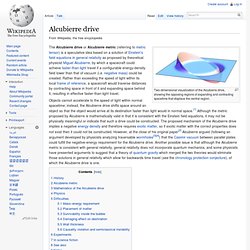
The Alcubierre drive or Alcubierre metric (referring to metric tensor) is a speculative idea based on a solution of Einstein's field equations in general relativity as proposed by theoretical physicist Miguel Alcubierre, by which a spacecraft could achieve faster-than-light travel if a configurable energy-density field lower than that of vacuum (i.e. negative mass) could be created. Rather than exceeding the speed of light within its local frame of reference, a spacecraft would traverse distances by contracting space in front of it and expanding space behind it, resulting in effective faster-than-light travel.
History[edit] Richard Feynman - Ode To A Flower. Does Our Universe Live Inside a Wormhole? A long time ago, in a universe much larger than our own, a giant star collapsed.

Its implosion crammed so much mass and energy together that it created a wormhole to another universe. And inside this wormhole, our own universe was born. It may seem fantastic, but a theoretical physicist claims that such a scenario could help answer some of the most perplexing questions in cosmology. A number of facets about our universe don't make sense. One is gravity. These conundrums may be a result of stopping the search for the riddle of the cosmos at the big bang, says Nikodem Poplawski of Indiana University in Bloomington. Enter the wormhole. Such a scenario could address the quandaries about gravity and the expanding universe. The calculations need further refinement, admits Poplawski, who will publish his findings on Monday in Physics Letters B. Cosmologist Martin Bojowald of Pennsylvania State University, University Park, won't even go that far.
If you enjoyed this article, you may also enjoy: White Holes and Wormholes. Stabilizing a wormhole with exotic matter In principle, a wormhole could be stabilized by threading its throat with `exotic matter'.
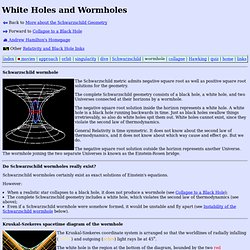
In the stable wormhole at left, the exotic matter forms a thin spherical shell (which appears in the diagram as a circle, since the embedding diagram is a 2-dimensional representation of the 3-dimensional spatial geometry of the wormhole). The shell of exotic matter has negative mass and positive surface pressure. The negative mass ensures that the throat of the wormhole lies outside the horizon, so that travellers can pass through it, while the positive surface pressure prevents the wormhole from collapsing.
Open-air quantum teleportation performed across a 97km lake. Sending signals through fiber optic cable is reliable and fast, but because of internal absorption and other effects, they will lose photons—which is a problem when the number of photons being sent is small.
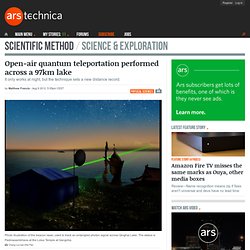
This is of particular concern in quantum networks, which typically involve a small number of entangled photons. Direct transmission through free space (vacuum or air) experiences less photon loss, but it's very difficult to align a distant receiver perfectly with the transmitter so that photons arrive at their destination. A group in China has made significant progress toward solving that problem, via a high accuracy pointing and tracking system. Using this method, Juan Yin and colleagues performed quantum teleportation (copying of a quantum state) using multiple entangled photons through open air between two stations 97 kilometers apart across a lake. Though the authors do not make this clear in the paper, their method is currently limited to nighttime communication.
Black-hole laser edges closer to testing Hawking - physics-math - 08 October 2012. Read full article Continue reading page |1|2 In a laboratory in Scotland, a revolutionary kind of laser is taking shape – the first one to be made out of an artificial black hole.
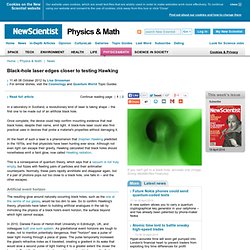
Once complete, the device could help confirm mounting evidence that real black holes, despite their name, emit light. Bessel Beams: The Coolest Physics Phenomena That Technically Don't Exist. What if every electron in the universe was all the same exact particle? Understanding 4th Dimention - HQ. One-electron universe. The one-electron universe hypothesis, commonly associated with Richard Feynman when he mentioned it in his Nobel lecture,[1] postulates that there exists only a single electron in the universe, propagating through space and time in such a way as to appear in many places simultaneously.
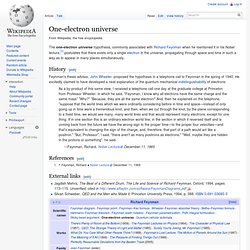
History[edit] Feynman's thesis advisor, John Wheeler, proposed the hypothesis in a telephone call to Feynman in the spring of 1940. What is Richard Feynman's "sum-over-paths" approach to quantum mechanics.